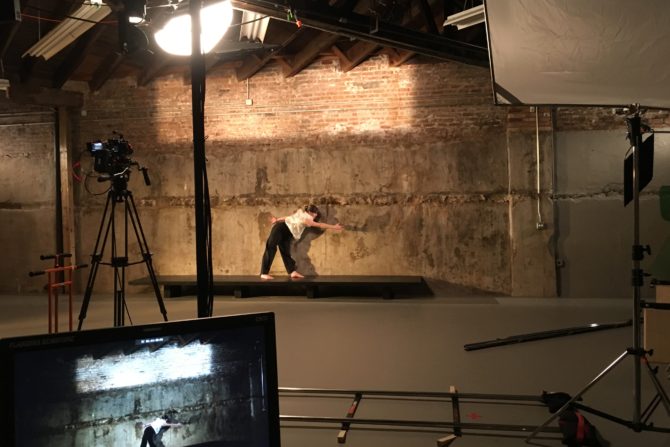Three presenters of experimental performance art are collaborating in three Chicago neighborhoods to present Video Corpo, a festival of video work celebrating movement-based artists who have used video as an extension of their practice and/or as an alternative corporeal perspective. Video Corpofocuses on broadening the audience for experimental time-based artists by creating a platform for viewing their work beyond traditional live performance.
Defibrillator, 1029 W. 35th Street in Bridgeport, opens Video Corpo November 16 at 7 p.m. with video installations by Marianne M. Kim, a Korean-American interdisciplinary artist working in screendance, multimedia installation, choreography, and performance art; Daniele Wilmouth, who creates hybrid forms of film, video, installation, and live art; and Michal Samama.
Video Corpo’s second opening event takes place November 17 at 7 p.m. at SITE/less, 1250 W. Augusta Boulevard in Noble Square, with the premiere of Zephyr’s The Wall Dance—Film Version (working title), an excerpt of Michelle Kranicke’s 2012 durational work Allowances and Occurrencesre-envisioned for the camera. SITE/less also presents Short Silent Films (1966–94) by iconic composer, singer, director/choreographer, and filmmaker Meredith Monk, and Nadia Oussenko’s On Falling, an exploration of falling and surrender.
Pivot Arts is presenting a one-night-only screening and panel discussion on Friday, November 30 at 7:30 p.m. at Chicago Filmmakers, 5720 N. Ridge Avenue in Edgewater. Films to be screened include All by Sarah C. Prinz, Danny Rosenberg, and Amy Wilkinson; Separate Sentences by Austin Forbord and Amy Dowling; Insan by Tommy Pascal; and Formidable Dreams by Sara Zalek. The post-screening panel includes Amy Wilkinson, artistic director of Chicago’s international dance film festival IN/Motion, along with artist Sara Zalek and other panelists to be announced, moderated by Pivot Arts Director Julieanne Ehre.
The directors of the three presenters—Michelle Kranicke (Zephyr and SITE/less), Joseph Ravens (Defibrillator), and Julieanne Ehre (Pivot Arts)—share their thoughts about Video Corpo.
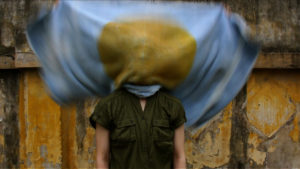
Why did each of you want to be involved in a festival that showcases movement and film, and how are you hoping it will create more interest in live performance?
Michelle Kranicke: As a choreographer, many of my conceptual ideas and much of my inspiration for imagery for my live movement works come from film. I knew that other choreographers have also experimented with film, and I was interested in creating an opportunity to present other voices, and my own experimentation, with media. In addition, I have known and respected the work of Defibrillator Gallery and Pivot Arts for some time, and with the opening of SITE/less, Zephyr saw a marvelous opportunity to partner with both organizations. I am hoping, through viewing the films presented in this festival, viewers will be intrigued and see a crossover between abstract imagery on film and in live performance—and to that end, extend their curiosity by seeking out live performance that uses imagery and abstraction as a way to stimulate multiple ideas around a work.
Joseph Ravens: While working toward my master’s degree at the School of the Art Institute of Chicago, I was introduced to the dance films of Daniéle Wilmouth (one of our featured artists), and we ended up working on several dance films together in various ways. Not only were these experiences rewarding, but they opened my eyes to new possibilities—new (and infinite!) ways to present movement-based work. I’ve been smitten with the form ever since. Perhaps those who attend the video installations and screening will become engaged with a particular artist, remember the artist, follow the artist, and, eventually, attend their live work. I guess I hope viewers think, “Gosh, I wish I could see this live and in person…”
Julieanne Ehre: Pivot Arts is thrilled to collaborate with such reputable presenters and creators of contemporary performance such as Joseph and Michelle—that was our prime reason for becoming involved—to foster more collaboration across the city with like-minded curators and presenters. Secondly, there is an exciting genre of dance works created for film. The In/Motion Dance Film Festival takes place at Loyola University, and we wanted to share some of the stunning works we’ve seen in this neighborhood festival with our audiences.
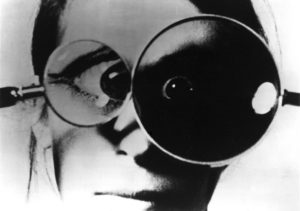
How did each of you choose the artists you are presenting?
JE: We worked with Amy Wilkinson, who is on our advisory board and is one of the main curators of In/Motion, to select artists who have presented with In/Motion with the idea of sharing them with Pivot Arts’s audience. Some of the artists, such as Sara Zalek, have worked with Pivot Arts, and this is an opportunity for our audiences to see how Sara uses film as a medium for her Butoh-influenced practice.
MK: In our initial conversations about artists, we talked about a seminal figure in the world of performance who also used film in their work to anchor the festival and present a foundation for the contemporary work being screened. Meredith Monk’s Short Silent Films 1964–1994 provided a terrific point of departure. First, they span a period of 30 years so viewers can see the artist’s development, and they also present a through-line for the other works in the festival. For the other films screening at SITE/less, Zephyr’s Wall Dance and Nadia Oussenko’s On Falling,viewers will be able to discern common aesthetics and timing of images.
JR: I invited artists who I’ve worked with in the past. I showed Michal Samama’s Screensavera couple years ago on a television in a hotel room as part of a project called Room 406. A subtle and beautiful work, I didn’t feel it got the attention it deserved, so I decided to show it again in a different setting. I’ve collaborated artistically over the years with Daniéle Wilmouth and Marianne Kim and leapt at an opportunity to showcase their independent projects. They have both influenced me tremendously.
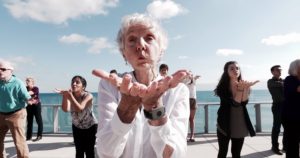
How does each of you envision Video Corpo as a way to expand audience for dance on film?
MK: Hopefully, Video Corpo will introduce dance on film to audiences that might not be aware choreographers and movers use the medium as another way to explore and present the body. All the artists we’re presenting have a strong Internet presence, giving viewers an opportunity to explore those artists, and others, that create movement performance for film.
JR: Video Corpo at Defibrillator will occur on the popular monthly 3rd Friday event at Zhou B Art Center. A lot of people who are unfamiliar with dance (or screendance) will stumble upon the work and, hopefully, find they appreciate what they see and support similar work going forward. Also, to present work live is a financial burden—travel expenses add up quickly. By creating a piece for video, it is possible for artists to share their work around the world. Showing the work in a gallery setting is also unique, expanding the possibilities for artists to put their work in front of fresh eyes.
JE: Many of our audience members are not familiar with the genre of dance on film, and this will be an exciting entryway for them into the work. It’s also an opportunity for Pivot Arts’s audiences to learn more about the work happening in Bridgeport at Defibrillator and with Zephyr Dance’s new SITE/less space.
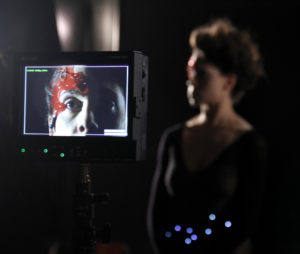
What role does each of your organizations play in this festival? How does it enhance this festival to have events at three locations?
JR: In Chicago I feel a lot of us stay within a few neighborhoods, rarely wanting to trek across town. Defibrillator recently moved from West Town to Bridgeport, and I realized that it wasn’t as far away as I thought. I’ve been exploring new and different neighborhoods and it’s been so rewarding. If this project motivates people to sample a new area of the city, our work is well done. Visiting a neighborhood once means you might return again. Also, I’ve been admiring the work at SITE/less and Pivot Arts for some time and embraced a chance to work together—the geographic crossover is a bonus. On a personal level, I’ve lived in all three neighborhoods at some point in my 20+ years in Chicago, so there is a sort of nostalgia in bridging these three neighborhoods.
JE: Pivot Arts produces works throughout the Edgewater, Uptown and Rogers Park neighborhoods to bring people to the far North Side of Chicago. We will present the films at the new Chicago Filmmakers space and are delighted to feature this Edgewater gem of an organization. Having three locations encourages audiences to explore what’s happening in the world of contemporary performance and dance throughout the city.
MK: SITE/less is a new venue in Chicago. A project of Zephyr Dance, SITE/less is as an experimental architecture, movement, and research center that seeks to rethink the relationship between the typical model of most performance venues and how the organization of those venues inevitably limits and conditions the curatorial practice. In addition, the project aims to facilitate connection with the public and promote social interaction. By presenting Video Corpo with Defibrillator and Pivot Arts, we not only introduce SITE/less to audiences who may not know about the venue because it is so new, we also showcase the broad reach of experimental art presented in Chicago by creating a festival that literally reaches from 35th Street in Bridgeport all the way to Edgewater and in between!

Photo captions top to bottom:
Molly Fe Strom in The Wall Dance courtesy of Zephyr Dance.
Martiality, Not Fighting by Marianne Kim.
Meredith Monk by Kenneth van Sickle.
Allby Sarah C. Prinz, Danny Rosenberg, and Amy Wilkinson; photo by Danny Rosenberg.
Remote Embodimentby Daniele Wilmouth.
On Falling by Nadia Oussenko.
